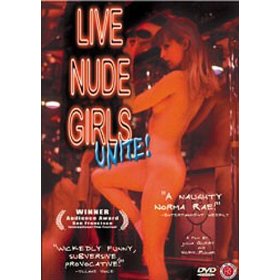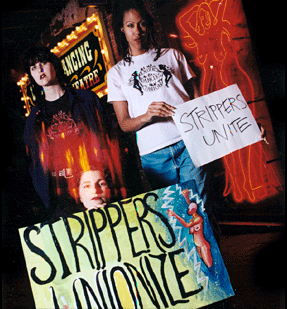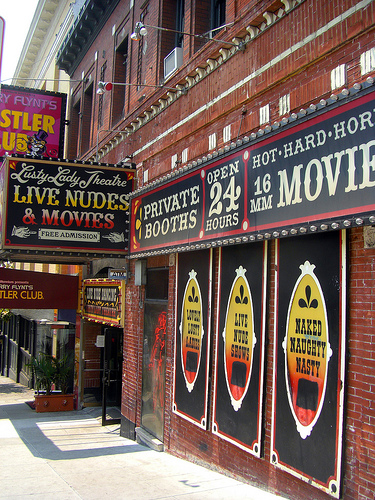Serendip is an independent site partnering with faculty at multiple colleges and universities around the world. Happy exploring!
Notes Towards Day 21 (Tues, Apr. 3): Re-thinking Sex Work


setting the scene by hwink and Colleen: Pink--Stupid Girls
I. Coursekeeping
Wednesday night Philosophy Consortium talk
on "re-thinking contraception"
MC and mbeale up for Thursday
for Thursday's class read Chapters 1, 7, 9, 11, 17, 19 from bell hooks'
2000 volume, Feminism is For Everybody: Passionate Politics; pp. 1-6, 37-43,
48-54, 61-66, 100-104, 110-118 (in our password protected file).
Alex Juhasz @ Re-Humanities (Swat last Thursday afternoon):
Feminist Online Spaces: Building & Linking Principled Sites in Collaboration,
esp. One Feminist Online Media Mantrafesto re:
re-making internet space from the inside
(consider what makes a story "spreadable":
slick quick jokes are the current "nature of virality");
critical voices need to be part of this conversation-->
cf. our Serendip course forum and webevents!
our in-class and post-class reflections from last week
put me in mind of Peggy McIntosh's 5 interactive phases
of curricular revision: Womanless History;
Women in History; Woman as Problem/Anomaly/
Absence in History; Women AS History;
History Redefined/Reconstructed to Include Us All...
we are @ different-yet-interacting stages in our educations:
some learning about sexual slavery/trafficking for the first time,
others have thought alot about how to respond to such practices,
with humility and respect for the agency of the people in their own
lives --is there room here/in feminism for all these positionalities?
michele.lee: I do not see classes offered about how to operate an organization that
works in international humanitarianism. Why can't it be like teacher certification?
dchin: I also wonder about the structure of non-profits themselves, and whether they
could and would benefit from organizing themselves more like the private sector.
S.Yaeger: At what point is problematic language a problem
that takes presidence [over funding action]? At what point does
abuse closer to home take priority over global abuses?
Where does actual progress and solution end and white knighting begin?
sara.gladwin: cf. how She's the First video promotes their usage of
twitter and social media with how few people have interent access
MC on the unintended consequences of Kristof's campaign:
negative impact on HIV programs, suspect conditions/activities of rehabilitation programs,
sex work driven underground, made more unsafe....women and girls should not be exploited,
but that doesn't mean that we should not interrogate the consequences of advocacy efforts
Teju Cole on The White Savior Industrial Complex: there is much more to doing good work than
"making a difference." There is the principle of first do no harm. There is the idea that
those who are being helped ought to be consulted over the matters that concern them.
mbeale on the pure audacity of international humanitarianism: it is blatantly cruel
to an extremely marginalized portion of the population within our own country who is
in need of justice…Instead of solely being conflicted on whether or not to poke one's
head into another culture's and country's problems, perhaps it is time we take time
to assess the mirroring issues on our own turf.
FrigginSushi: I've always thought this same thing when it comes to ... goiong into
another country ... to "protect" its people, but ...on the other side ....it's somewhat
admirable that Half The Sky is serving as a tool to get the word out to people who
...can privately fund things that would help the situation....I don't know. I'm conflicted.
epeck: I'm not sure that I buy this.... we do not have to be perfect in order to provide
valuable help, and perhaps our helping of other people will make us realize what we
need to work on ourselves.
aybala50: Is it possible that we can do both?...isn't it possible for everyone to do
what they can. Maybe some people are able to reach out to another who is close by,
while others have the means to reach out further?
Colleen: Whether we're talking about "saving" these women or talking
about how it's not our place to "save" them, we are still sitting around
discussing the fate of people who are not at the table.
dear.abby: it is harder to hear about/concieve of problems as close to home
epeck: if culture and geography are socially constructed, why can't one person
just try their best to help another?...I just don't see how we can bend the social
construct of gender in this class, but remain so rigid with all of these other constructs.
buffalo: would it be better to just be ignorant and not know what’s going on?...
I don’t think it’s wrong to want to put effort into helping people who are suffering
S.Yeager: I really dislike the idea of putting down anyone's effort to help another
human being...I just wish that we could get past the idea that abuses only occur
in particular places.
pejordan: There is never one solution to these complex problems, and it would
be naive to think that there is, but I believe that each of us can find ways to help.
II. today's film is about self-organizing (self-helping?) --
might looking @ it together help us answer, again, some of these questions?
![]()

Julia Query and Vicky Funari's Live Nude Girls Unite!
"a truly queer film" (??) portraying
* the unionizing of the "Lusty Ladies,"
* the coming out (as a lesbian and as an exotic dancer) of one of them;
* and her conversation/relationship with her mother.
Describe your initial reactions to one another (in groups of 2 or 3):
how did you feel, watching the film?
what did you notice, about how it was made?
what did you learn?
what questions do you have?
What did you learn, from cf'ing reactions?
I'm particularly curious about how the generational divide strikes y'all...

Write now for 5 minutes in response to these prompts
(following the mantra from Kate Bornstein's "Ten-Minute
Gender Outlaw Exercise" in The Gender Workbook):
The trick is that the answers have to be phrased in questions...
it keeps the questions open, which is where I think they belong....
The point is to get to a question you want to think about some more,
one that really tickles your brain--something you can ponder on
for the balance of the day. Once you get to that question, you stop."
Is sex work inherently degrading?
Is sex work a liberating expression of
free choice and sexual independence?
Is sex work "just" a job?
Why does it have to be one or the other?
What have we written?? (Go 'round and read one question)
III. What might get highlighted, if we put Query
& Funari's film into conversation with ....
![]()
** Kristoff & WuDunn's Half the Sky....?
** Kamala Kempadoo's essay, "Women of Color and the Global Sex Trade,"
which asks us not only to consider sex work as an income-generating activity,
but also to think about women's sexual agency, needs, desires
** Ross Kauffman & Zana Briski's film, Born into Brothels, which
uses photography "to capture the imaginations of children, to
empower them, building confidence, self-esteem and hope."
**the material on feminist documentary-
making we discussed in mid-February?
A. Institutional Framework
"the creative treatment of actuality" or
"direct, truthful access to the real"--one
of the prime attractions of the form
B. Community of Practitioners
mandate to represent the historical world
rather than to imaginatively invent alternative ones....
an impression of authenticity
C. Corpus of Texts
Norms and conventions: voice-of-God commentary, interviews,
location sound recordings, cutaways to provide illustrative images,
reliance on social actors, or people in their everyday roles and activities,
an informing logic of problem solving
D. Constituency of Viewers
a documentary lies in the mind of the beholder, an
assumption that the text's sounds and images have
their origin in the historical world we share, were not
conceived and produced exclusively for the film
which of these--and/or what else--do you find
most useful as a frame for discussing the film?
what questions would you have asked
Funari, had she been able to join us today?

| Attachment | Size |
|---|---|
| Battin.pdf | 1.12 MB |


